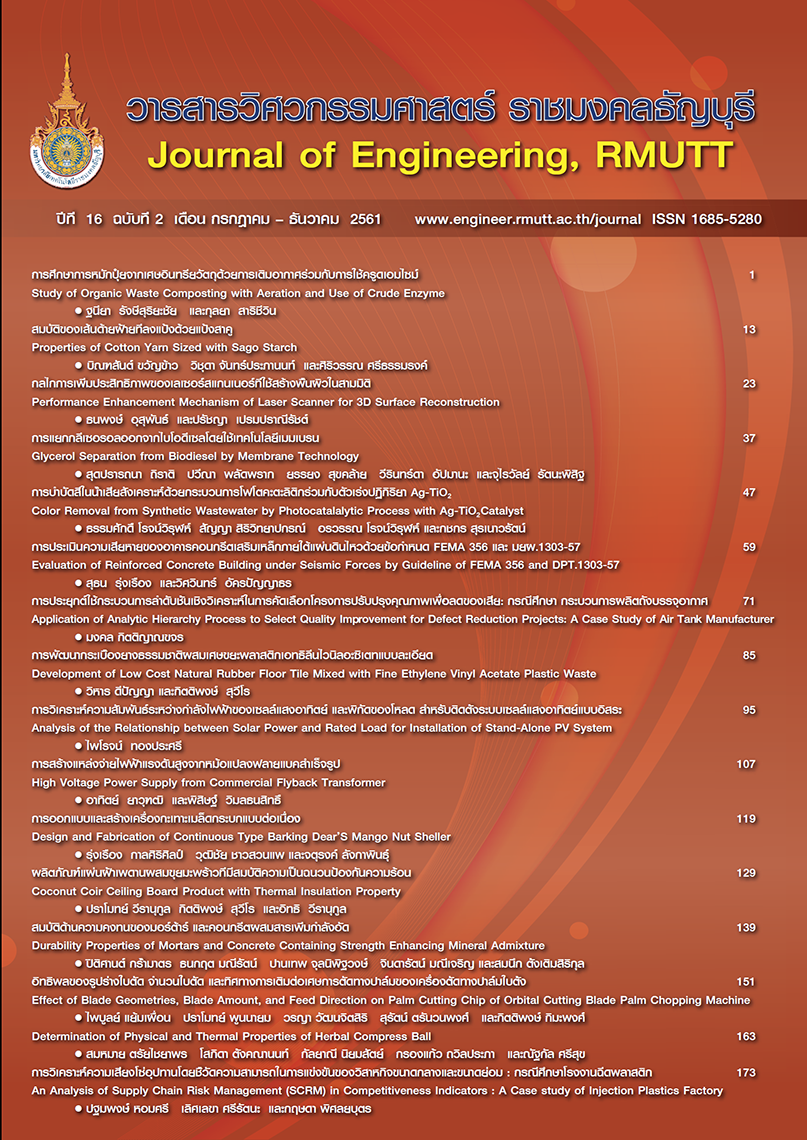Development of Low Cost Natural Rubber Floor Tile Mixed with Fine Ethylene Vinyl Acetate Plastic Waste
Main Article Content
Abstract
This research aims to develop the natural-rubber floor tiles mixed with fineness ethylene vinyl acetate plastic wastes (EVA plastics) from the factories. The study use natural-rubber STR 20 at 100 phr with various contents of EVA plastics (e.g. 0, 5, 10, 20, 40, and 80 phr) and then mixed with chemical substance at constant ratio include zinc oxide at 5 phr, stearic acid at 2 phr, mercaptobenzothiazole at 0.5 phr, diphenyl guanidine at 0.2 phr and sulfur at 3 phr. The samples are ground by two-roll mill and formed by compression molding at 150 degree Celsius with 30x30x0.2 cm of dimension. The properties of the natural-rubber floor tiles are tested under ASTM standard. From the results, it is found that the natural-rubber floor tiles mixed with 10 phr of EVA plastics is the suitable ratio for using as the rubber floor tiles in building. This ratio can increase the hardness, tensile strength and wear resistant properties, and decrease the density and thermal insulation properties when compare to the natural-rubber floor tiles without EVA plastic.
Article Details
The manuscript, information, content, picture and so forth which were published on Frontiers in engineering innovation research has been a copyright of this journal only. There is not allow anyone or any organize to duplicate all content or some document for unethical publication.
References
The Thailand Research Fund. Research Fund Announcement of Small Research Project in Para Rubber Topic. Bangkok: The Thailand Research Fund; 2005. (in Thai)
Pongpan Worrasoontaroste. Construction Materials. Bangkok: Se-Education Publishers; 1997. (in Thai)
Prachoom Khamput and Kittipong Suweero. Using Vulcanized Latex to Develop the Properties of Concrete Block Mixed with Ethylene Vinyl Acetate Plastic. Proceeding of 8th Annual Concrete Conference. Chonburi: ACI Partners with Thailand Concrete Association; 2012. (in Thai)
American Society for Testing and Materials (ASTM). Annual Book of ASTM Standards. Philadelphia: American Society for Testing and Materials; 2014.
Dupont. Compare EVA Grades and Performance Properties. Delaware: E.I. du Pont de Nemours and Company; 2012.
Subramanium, A.. Molecular Weight and Molecular Weight Distribution of Natural Rubber. RRIM Technology Bulletin. 1980; 4: 1-25.
Barlow, Fred W.. Rubber Compounding : Principles, Materials, and Techniques. 2nd ed. Florida: CRC Press; 1993.
Jesse Edenbaum. Plastics additives and modifiers handbook. New York: Van Nostrand Reinhold; 1992.
Holfmann, W.B.. Rubber Technology Handbook. Munich: Hanser Publishers; 1989.
Tanunchai Pakunworakij, Pantuda Puthipiroj, Woratham Oonjittichai and Panjira Tisavipat. Thermal resistance efficiency of building insulation material fromagricultural waste. Journal of Architectural/Planning Research and Studies. 2006; 3(4): 119-126. (in Thai)


